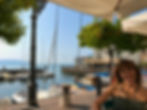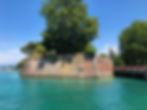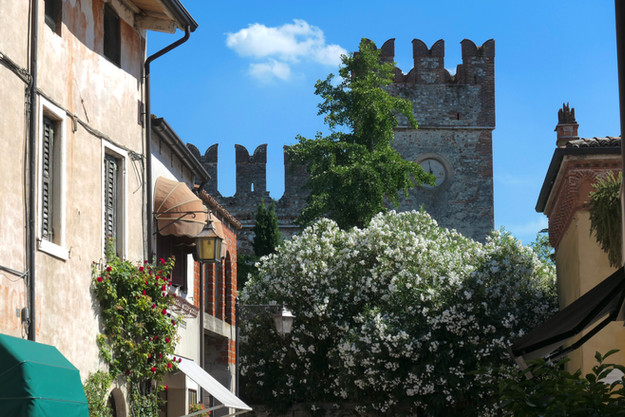Lago di Garda Highlights, Part 2
- Mike
- Jan 10, 2022
- 12 min read
Updated: Sep 26, 2024
Continuing on from Part 1 of Lago di Garda Highlights which ended in Malcesine, we’re hopping back across the lake to the western side again to our favorite town on the entire lake.


Gargnano, Brescia
Easily confused with both Gargano and Gragnano when speaking or writing, Gargnano is small, relatively quiet, full of locals and not on the itinerary of the vast majority of tourists, so exactly our kind of place and definitely one of the Lago di Garda highlights.

D.H. Lawrence had the same thought in 1912 when he took lodgings at the Villa Igea just one block from the lake on Via Colletta. He was accompanied in an elopement of sorts by Frieda von Richthofen, daughter of a German baron and distant relative of the soon-to-be famous ‘Red Baron’ German flying ace.
At that time Frieda was also the wife of his old University professor in Nottingham and a mother of three children so it was something of a scandalous relationship for that era. They spent the winter in Gargnano while Lawrence finished writing ‘Sons and Lovers’ and started working on the travel essays that were to become ‘Twilight in Italy’.
In a letter to his editor, Edward Garnett, shortly after arriving Lawrence wrote: “ Gargnano is a rather tumble-downish place on the lake. There is a lovely little square, where the Italians gossip and the fishermen pull up their boats, just near. Everything is too nice for words – not a bit touristy – quite simply an Italian common village.”

Thankfully not a lot has changed, at least in physical appearance, in the intervening century since that was written. Lawrence’s little square right on the water just off Via Colletta called Piazza Villa (above) still has room for a few boats and the tavern where Lawrence slaked his thirst is now a small restaurant called Bar Osteria al Porto di Villa serving pizza and simple dishes. This is primarily a residential area and the equally attractive Piazza Feltrinelli a few hundred yards away along Via Roma is where all the shops and restaurants are to be found.

We stayed a few days in Gargnano at the Albergo du Lac (right) which is almost next door to Lawrence's old digs in Via Colletta and we would certainly recommend the hotel, though it may not be for everyone.
It’s the sort of old fashioned place that we are drawn to, more house than hotel and run by the same family for a couple of generations. I’m sure the same people go back year after year because it feels like one of those places and if you watch the video of the hotel on its website and see its fabulous position right on the lake you will immediately understand its appeal.
We were in Malcesine and Gargnano during the same week and the difference was noticeable in the sense that Gargnano is much less touristy, just as Lawrence described it in 1912, so this type of hotel suits the slightly unfashionable atmosphere here. Albergo du Lac's restaurant is also very good, though understated and quiet, and we dined one other night in the extensive outside garden at their sister hotel nearby, but the town itself is not short of excellent restaurants so there is plenty of choice.

Gargnano has also seen its fair share of history and even took some direct hits from the Austrian navy in the third Italian war of independence in 1866. It wasn’t until a little later that Veneto joined the rest of unified Italy but Riva del Garda and the whole of Trentino had to wait until the end of World War 1 in 1918.

Gargnano is home to the Palazzo Feltrinelli, now used by the University of Milan but between October 1943 and April 1945 it was Mussolini’s headquarters of the short-lived Salò Republic.
This was the last stand by Italian fascists loyal to Mussolini after he had been rescued from captivity high up on the Gran Sasso mountain in Abruzzo by German paratroopers in a very daring glider mission.
Nearby is the Villa Feltrinelli, now a posh hotel, which was Mussolini’s personal residence during this period so the unfortunate citizens of Gargnano had to put up with the constant daily security hassles of having a paranoid deposed dictator in their midst for 18 months while all around them the Second World War ground on in this part of Italy; in fact the war ended while German troops were still holding Riva del Garda and Torbole.

Like Limone sul Garda, this stretch of lakeshore was famous for its lemons and in fact there are more old limonaie in Gargnano today than in Limone itself, some of which are still in use. Lawrence was quite taken with the lemon houses and their heavy fragrance and described how all the lemons, oranges and the much larger citron were cultivated by grafting them onto a bitter orange stock because the seed-grown plants fell prey to disease. Even in 1912 it was clear to him that it was a dying business and he commented on all the limonaie that were for sale and others already in ruins.
Capers also are a local crop, growing wild on green bushes with white flowers and bits of purple. They proliferate among the stone walls and limonaie, enjoying the Mediterranean climate in the same way as the lemons and olives. There is a dish here that uses the local ingredients of lemons, capers, whitefish and Lago di Garda olive oil, all mixed with potatoes but I haven’t yet found a proper recipe for it.

As far as getting some morning exercise in Gargnano, not surprisingly all you have to do is go straight uphill on a combination of paths and quiet roads to Via Angelo Feltrinelli where there is a punto panoramico directly above the Hotel du Lac. For a more formal hike, a popular route is to make the short drive to Sasso and take the path to Eremo di San Valentino, a walk which takes less than an hour and involves no more than 800 feet of ascent.

Sasso is one of 12 hamlets making up greater Gargnano, most of which are on the slopes above town and connected by small scenic roads interspersed with olive groves and woods including many chestnut trees.
These roads are all very quiet with dramatic lake views and being unsure of the local paths I ended up partially on the roads each morning without noticing much traffic at all.
Toscolano Maderno and Gardone Riviera, Brescia
Remaining on the western side of the lake, just a few miles south of Gargnano is the town of Toscolano Maderno. When tourism first started on the lake well before Lawrence's winter sojourn in Gargnano, some beautiful villas were built in Maderno (Toscolano being the more industrial half of this joined-up town) and the ones that remain can be seen on the mostly pleasant three mile promenade along the lakefront which goes around the promontory.
This is more of a resort for younger people as there's more going on here than in Gargnano and also for families because there are long stretches of pebble beaches providing easy water access.

Towards the end of the promenade where it gets a bit scruffy is the Church of St Peter and St Paul, which is a veritable art gallery displaying works by the famous Venetian painter Andrea Celesti who spent many years here at the end of the 17th century when he had to leave Venice in a hurry after having incurred the wrath of the Doge by painting him with donkey's ears. His frescoes cover every square inch of the interior of the church.
The 5,000 feet Monte Pizzocolo dominates this part of the lake (above photo) making it yet another favorite spot for serious hikers. Maderno for us, even more so than Limone sul Garda, is a day trip sort of place rather than an overnight stay but it really depends on what you are looking for on your holiday to Lago di Garda.

There is only one reason for including Gardone Riviera in an article called 'highlights' and that is the amazing but strange Il Vittoriale.
For those people who aren't familiar with one of Italy's most iconic but controversial figures of the late 19th century and first third of the 20th century, Il Vittoriale was the home and decidedly eccentric project of Gabriele D'Annunzio.
His impact on Italy during his life should not be understated in terms of literature, politics, nationalism and war and I've written a review of Lucy Hughes-Hallet's recent biography of D'Annuzio.

The tour of Il Vittoriale just above the lake here I found fascinating but just like everything else about D'Annunzio it only served to deepen Elena's antipathy for the man. D'Annunzio's main residence showcases some very extensive and bizarre collections while outside there is a complete ship perched incongruously on the hillside, having been cut up into pieces, dragged up the hill and reassembled where it sits today.
Bardolino, Verona
We had high hopes for the town of Bardolino, having read only good things about it, and it's certainly a very attractive town with a charming pedestrianized waterfront. However it's a bit of a nightmare anytime around high season because this town clearly has no compunction about sacrificing authenticity for tourism.

There are a few tell-tale signs that we look out for that are always present when an Italian town has sold its soul; the first is when the main street has become nothing more than a long line of bars and restaurants serving meals all day, unappetizingly described outside on big plastic menus written in German and bad English.
In that sort of environment you won't see many Italian customers, the food won't be very good and they will all open early and stay open until very late. The second warning sign is when the few places not making money from sales of booze, cater exclusively to tourists and display rows of fridge magnets outside their shops.

And if you go to a town like this out of season then it's sometimes even worse because the few locals that remain can't sustain all the restaurants and bars so they simply shut them down at the end of the season and it becomes a ghost town with no identity at all.
Having said all that, once you reach the harbor area and the lakeside path there's a notable improvement because the town planning authorities have wisely allowed the lakefront to remain unspoiled. The path itself goes north to the nearby town of Garda and south as as far as Lazise and it makes for a pleasant walk or gentle bike ride. Bardolino is also well connected by ferry so it can be visited for the day while staying somewhere else without all of the hassle of driving or an overnight stay.

We managed to find a decent place for a light lunch well away from the main drag before we headed up into the hills for our appointment at Le Fraghe and our suggestion would be to spend a few hours in Bardolino early in the day enjoying a coffee and pastry and then go just a short distance south to Lazise for lunch.

There's no real need to stay overnight in Bardolino because it's such a short drive to somewhere like Domus Cariana in San Pietro in Cariano where you don't have to pay a king's ransom for parking overnight, struggle down narrow streets with luggage and be kept awake until the early hours by the sort of people you came to Italy to avoid.

Enough about the town of Bardolino, but before moving on to Lazise it's worth commenting briefly on the hills of Bardolino above the lake and town. We would certainly recommend a visit to Le Fraghe (but read our lengthy description of Matilde Poggi's wines first because her wines might not be to everyone's taste) in these hills but much of the area between Bardolino and the Adige river is taken up by industrial areas and complicated autostrada exits with heavily trafficked roads serving the local marble workshops. East of the Adige river in the Valpolicella hills is therefore a safer bet to find quieter and more attractive countryside unless you really know your way around.
Lazise, Verona

Barely more than three miles south of Bardolino, Lazise offers up a slightly different atmosphere. It's not immediately obvious when you walk through the old arch into town and it's not easy to put your finger on the specific reason why it's so much more appealing because these things are often very subjective.
Lazise certainly gets its fair share of visitors because everywhere in the south-east quadrant of Lago di Garda is popular and parking here is expensive and can be a problem if the large car park directly outside the walls is full, but once you're inside the town there's a noticeable improvement on Bardolino, at least for us.
We visited both places on the same day and we much preferred Lazise. The restaurants looked much better and the town was certainly less crowded. On the subject of restaurants in Italy, after 8 years traveling around we can usually identify a good restaurant in two minutes flat just by reading the menu in Italian and poking our heads inside for a quick look at certain signs that are not necessarily obvious to most visitors.

Lazise is a town whose history goes back as far as you care to look. The Romans were here of course but it was the della Scala family, the lords of Verona in the 14th century, who left the biggest physical legacy in the form of the medieval castle and walls, most of which have been maintained in excellent condition.

Lazise has decent ferry connections and staying here and using the ferry service to visit Peschiera del Garda and Sirmione wouldn't be a bad plan because, though the Roman villa at Sirmione is definitely worth visiting, we wouldn't want to stay in Sirmione itself.
One of the disadvantages for me with the Bardolino to Peschiera del Garda section of Lago di Garda is that it's quite flat inland from the lake and there's no ability to walk up onto even the gentle slopes above these towns because there is a whole mess of busy roads to cross. It's very different to the area around Malcesine or Gargnano where part of the experience of staying on the lake also includes being able to walk up the nearby hills and enjoy the views at different times of day without any hassle from roads or heavy traffic. On this part of the shoreline, the lake is really all there is.

Peschiera del Garda, Verona
If this town were anywhere else it would be much easier to recommend because it's an interesting place in a very convenient location being at the extreme southern end of Lago di Garda and on the main autostrada from Milan to Venice that goes through Brescia, Verona, Vicenza and Padua. The problem is that it has too much competition from all the other towns around the lake for it to stand out if time is short.

However, not for nothing is it now a UNESCO world heritage site, largely because of the Venetian defensive fortifications and the fortress that survive. Peschiera has been in the middle of just about every war in northern Italy over the past 500 years, especially those of the Napoleonic era and later during the three wars of Italian independence.
The waterways in Peschiera are a big part of its charm; the river Mincio exits the lake here and flows down to Mantua before joining the Po and along the way it forms the border between Lombardy and Veneto. As you wander around the centro storico it's obvious that Peschiera is a very normal town today and now that I've introduced the 'fridge magnet' test for authenticity, I'm pleased to say that I didn't see any here. Perhaps the best way to describe Peschiera is that it has the same relationship to the other more glamorous Lago di Garda towns nearby as Rapallo has to its Riviera di Levante neighbors in Liguria.
Sirmione, Brescia
A good time to have visited Sirmione would have been when the Victorian Poet Laureate Alfred Lord Tennyson was here in 1880 and wrote a poem in praise of his fellow poet, the Roman Catullus. Or earlier still when Catullus himself made the short trip here from his native Verona 2,100 years ago. Or much later perhaps when Ezra Pound wrote to James Joyce from Sirmione in 1921 imploring his friend to spend a week with him here. Or maybe the best era for Sirmione was the 1950s when the great opera singer Maria Callas called it home.

But whichever period was the heyday for Sirmione it's clear that it was somewhere in the past and already over, because today not only does Sirmione fail the 'fridge magnet' test but it goes one step further and also fails the 'trenino' test, ie the large scale toy train that ferries tourists through the small town to the Roman villa at the very tip of the peninsular.
I could tell that arriving at Sirmione by car was a mistake when still a couple of miles away we came across acre after acre of car parks on the right hand side of the only road in and out. Most of them in late June were already full of coaches from just about everywhere and coincidentally there was even one from Lucca right next to one of the few remaining spaces left. After parking, there is still some way to walk to reach the town and then after squeezing past the throng of tourists at the castle entrance there is another three quarters of a mile to the Roman villa, hence the trenino.
After our experience, the best advice we can give you is not to drive here, but to get the ferry from wherever you're staying on Lago di Garda, then ignore the town and go straight to the Roman ruins where it's also much quieter. When they were first discovered in the 15th century the Venetians thought they were natural caves and had no idea initially that they had stumbled on one of the most important Roman sites in northern Italy.
The location of the villa has to be the best on the entire lake with water on three sides and views in every direction. There's a substantial amount of the ruins still standing and if you reduce the hassle factor by arriving and departing by ferry you'll return home with more pleasant memories of Sirmione than we have.
And finally, two photographic examples are shown below from Sirmione of the 'fridge magnet' test and the 'trenino test'. Coming across one of them on your travels is a warning sign that you might have picked the wrong place and seeing both of them means that you're in Disneyland and no longer in Italy.























